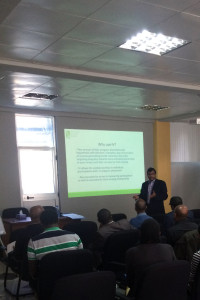
Dr. Khandker leading a discussion on M&E during the two-day workshop. Photo credit: IFPRI/REAP (G. Abate)
In September, Dr. Shahid Khandker, IFPRI visiting Senior Research Fellow, conducted two trainings at the Ethiopian Agricultural Transformation Agency (ATA) on developing a Monitoring and Evaluation (M&E) system. The first training was geared towards policy makers and senior staff at ATA while the second training was targeted to policy analysts and project managers.
Monitoring and Evaluation (M&E) in Practice
This seminar was designed for the senior management team at the ATA and policymakers in Ethiopia to introduce the merits of developing a Monitoring and Evaluation (M&E) system. The half-day seminar covered topics such as why, what, and how to monitor and evaluate programs and policies. It also covered how an M&E framework can be designed and implemented. The two main objectives of the training are to:
(a) Enhance the understanding of senior directors and managers of ATA on the design and implementation of an M&E system; and
(b) Help senior staff develop an M&E strategy for ATA.
View and download the presentation:
Monitoring and Evaluation: General Principles and Practices
Two-Day Course on Impact Evaluation
The goal of this course is to provide policy analysts and project managers with the tools for evaluating the impact of a project, program or policy. This course provides information on the methods that can be used to measure the impact of a project, program or policy on the well-being of individuals and households. The course addresses the ways in which the results of an impact evaluation may be put to use – such as, to improve the design of projects and programs, as an input into cost-benefit analysis, and as a basis for policy decisions.
By the end of this course, participants will be able to:
- Describe the purposes of an impact evaluation.
- Explain why an impact evaluation requires the construction of a counterfactual and why this is difficult to do.
- Summarize the steps required in an experimental design, and assess the applicability of this method of impact evaluation.
- For each of the main types of quasi-experimental design – matching comparisons, double differences, instrumental variables, and related comparisons using discontinuity approaches – summarize the steps needed to apply them, and the data requirements, and evaluate their applicability and usefulness.
- Describe the methodological approaches and main findings of several of the most important impact evaluations that have been undertaken in the areas of health, education, income support, and credit.
- Explain how the results of impact evaluations may be interpreted and then used to inform policy.
View and download the presentations:
Module 1: Accelerating Growth and Poverty Reduction in Ethiopia
Module 2: Basics of Impact Evaluation (IE)
Module 4: Propensity Score Matching (PSM)
Module 5: Double Difference (DD) Methods
Module 6: Instrumental Variables, Regression Discontinuity Models, Pipeline Methods






















